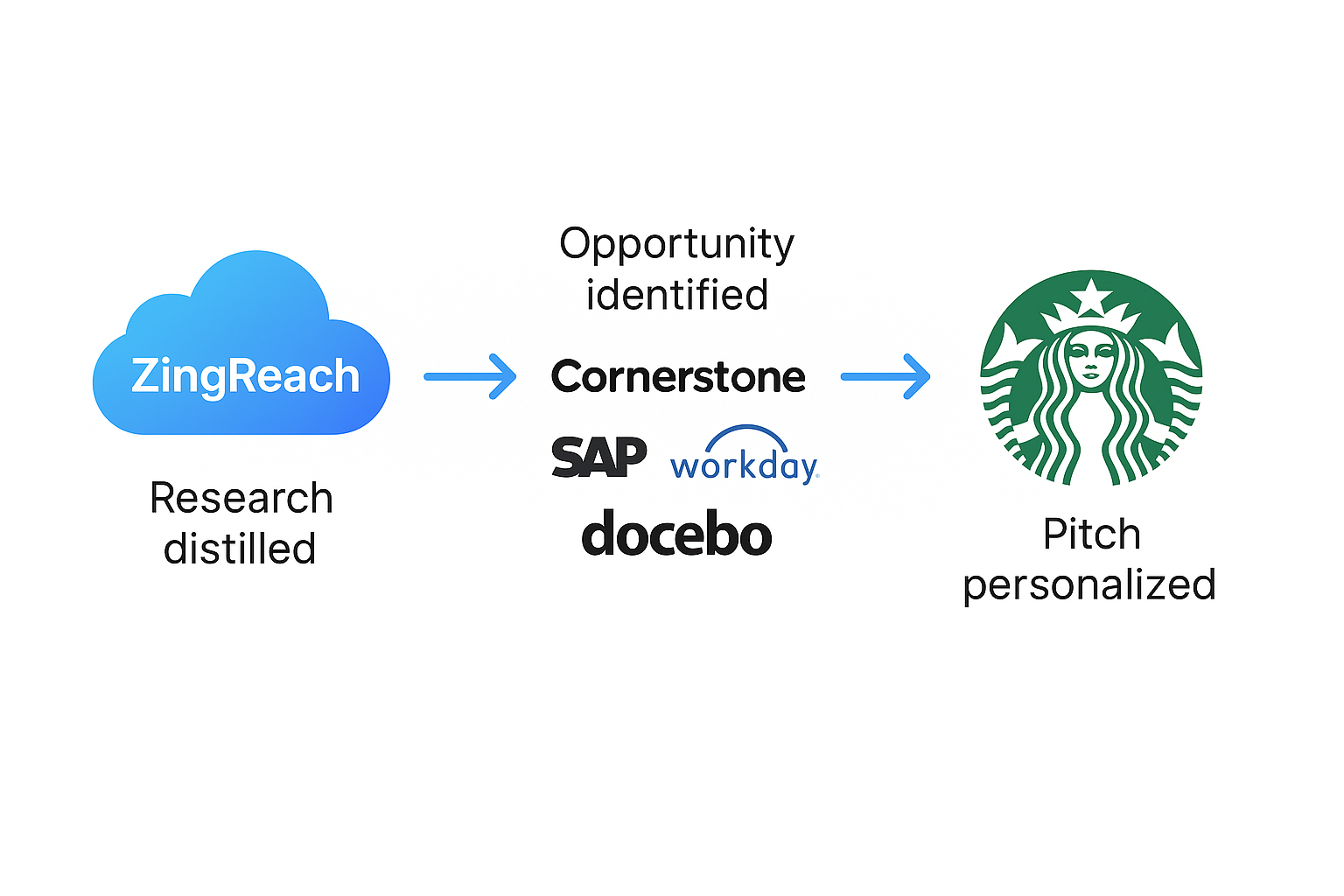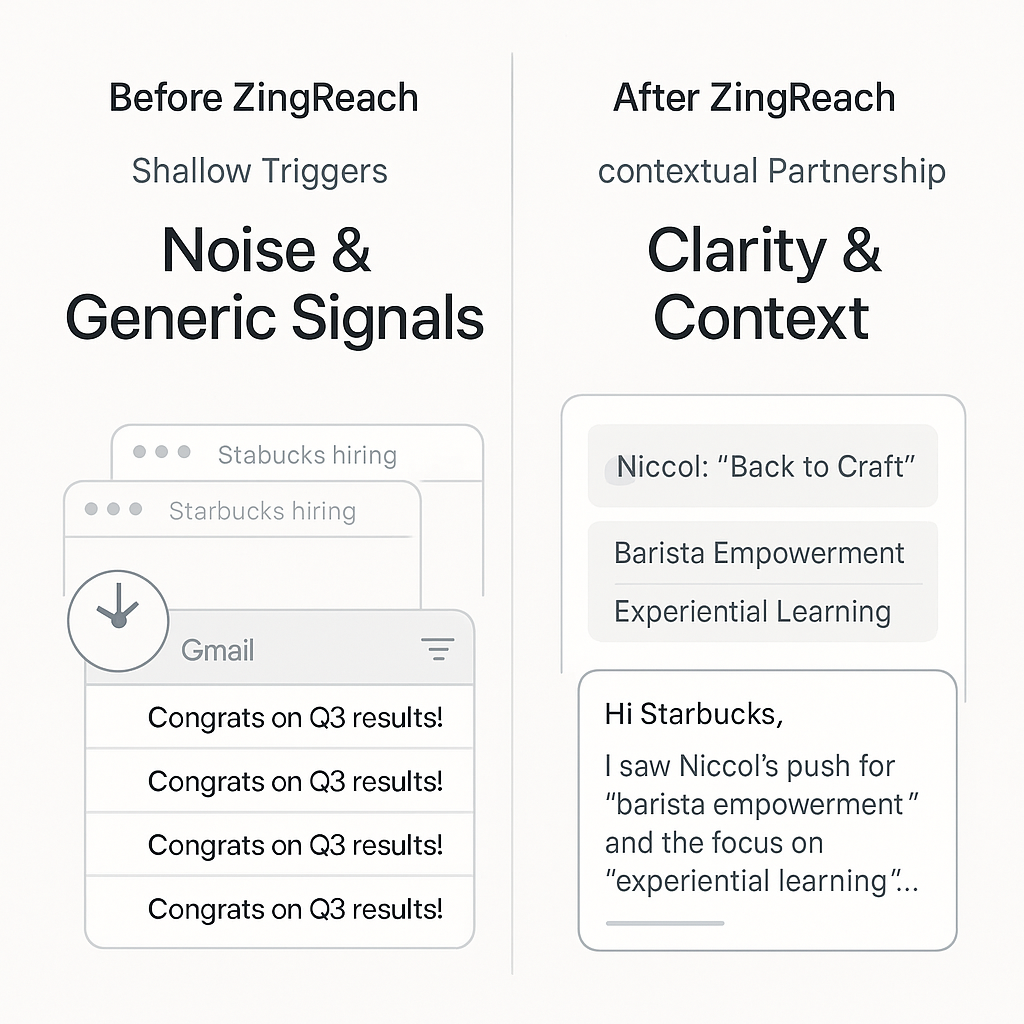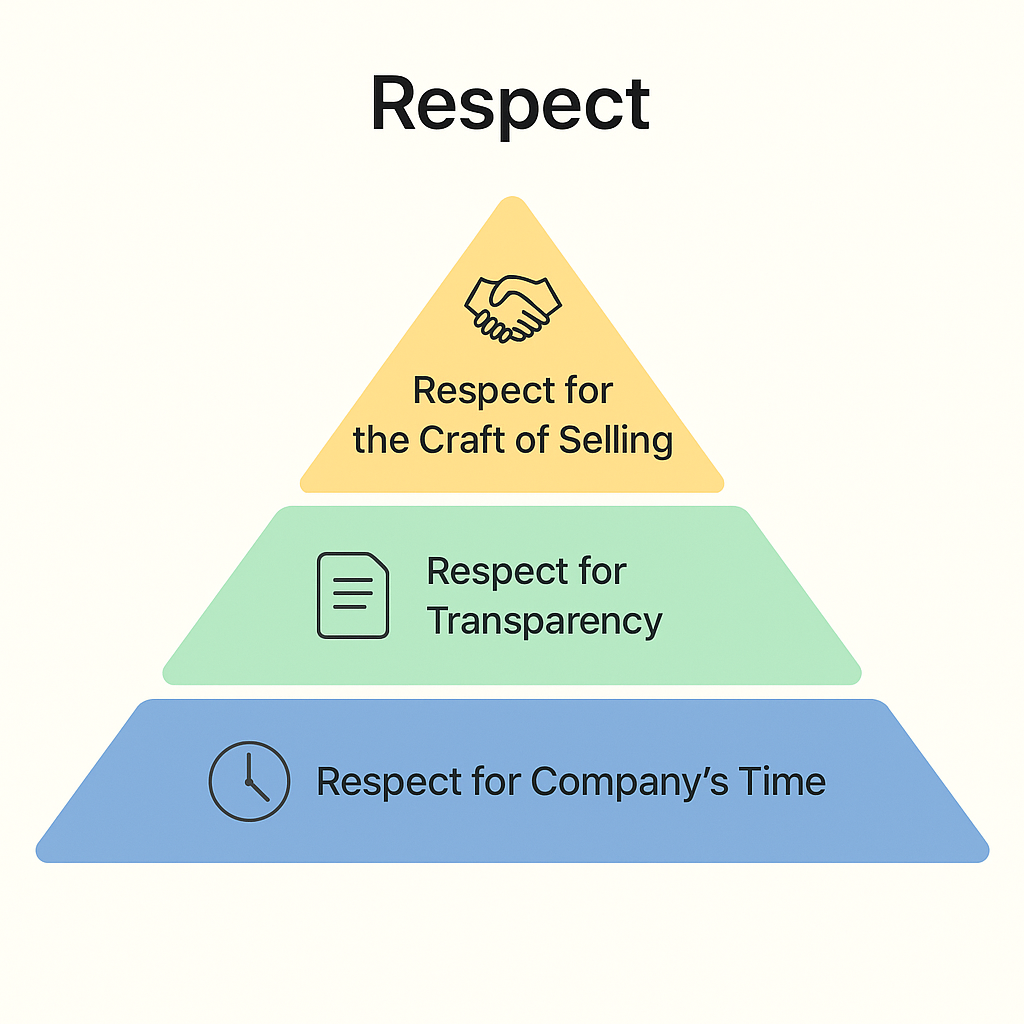
The Art of the Perfect Pitch: How to Sell with Respect in the Age of Transformation
Introduction: Why Starbucks Matters Right Now
Starbucks is in the middle of one of retail’s most fascinating reinventions. CEO Brian Niccol is leading a “back to craft” push: simplifying menus, empowering baristas, and reintroducing the human touch that made the brand iconic.
This is not happening behind closed doors. Starbucks has been transparent about its challenges and its vision. The interviews, investor calls, and press releases are all out there for anyone to see.
For sales teams, especially in industries like training and employee development, this is gold. The opportunity is not to send a generic email. It is to show up with a pitch that connects directly to what Starbucks is actually trying to do.
The Old Way: Generic Signals, Generic Pitches
Here is what usually happens:
- A Starbucks job posting goes live, and dozens of reps send the same “I saw you are hiring” message.
- An earnings call transcript is posted, and inboxes flood with “Congrats on Q3 results!” notes.
- A story mentions “barista training,” and every rep suddenly positions their product as the answer.
The intent is there, but the execution is shallow. The result: wasted time for reps and inbox fatigue for Starbucks leaders.
The Cost of Lazy Research
- For sales reps: Hours wasted chasing irrelevant “triggers” that do not lead to meaningful conversations.
- For companies like Starbucks: Decision-makers drown in noise, tuning out even the vendors who could actually help.
- For the market as a whole: Real solutions get lost in the flood of generic pitches.
What could be a consultative conversation turns into background spam. Everyone loses.
The New Way: Research That Respects
Now imagine a rep from Cornerstone, SAP SuccessFactors, Workday, or Docebo calling Starbucks and saying:
“We have been following Brian Niccol’s push to bring back personal connection, from Sharpies on cups to ceramic mugs to barista empowerment. Rolling out a cultural shift like that across 38,000 stores requires a new kind of training infrastructure. We have worked with other retailers during similar transformations, and I would love to share what we have seen.”
That is not creepy. It is not guesswork. It is simply acknowledging what Starbucks itself has put in the public domain, then framing a solution in that context.
Where ZingReach Fits In
The hard part is not knowing Starbucks is changing. The hard part is translating that change into a real opportunity for a vendor.
For a learning management system (LMS) provider like Cornerstone, SAP SuccessFactors, Workday, or Docebo, the obvious question is: what does Starbucks’ “back to craft” agenda mean for training?
- Starbucks is empowering baristas to deliver more personal customer experiences. That implies new training modules focused on soft skills, not just compliance.
- Starbucks is redesigning its stores around connection and pace. That suggests rolling out experiential learning across thousands of locations, consistently.
- Starbucks is simplifying operations and rethinking staffing models. That creates a need for scalable onboarding that still feels personal.
This is where ZingReach becomes the bridge. It does not just summarize Starbucks’ public statements. It organizes them into themes, timelines, and pain points that map directly to training opportunities.
- A rep at Cornerstone does not have to guess if Starbucks is ready to talk about training infrastructure. They can see where training aligns with the CEO’s priorities.
- A Workday rep does not have to skim a dozen press releases. ZingReach surfaces the exact leadership quotes and timelines that matter.
- A Docebo rep does not have to cold call with a generic LMS pitch. They can tie their platform to Starbucks’ stated goals of barista empowerment and operational consistency.
In other words:
ZingReach → translates Starbucks’ vision into vendor-specific opportunities → so LMS providers can pitch solutions that feel like partnership instead of spam.
Before and After: The Starbucks Example

Before ZingReach
- 9:00 AM: Google “Starbucks training.”
- 9:30 AM: Skim three generic articles.
- 10:00 AM: Draft email: “Hi, we help companies improve employee training.”
- 10:15 AM: Blast to multiple Starbucks contacts.
- 10:16 AM: Silence.
After ZingReach
- 9:00 AM: Type “Starbucks” into ZingReach.
- 9:02 AM: See summary of Niccol’s back-to-craft initiatives, leadership changes, and training implications.
- 9:05 AM: Draft pitch tied directly to those initiatives.
- 9:15 AM: Call Starbucks with specific, relevant value proposition.
- 9:20 AM: Conversation begins.
The difference is night and day. One approach feels like noise. The other feels like partnership.
Why This Matters
For Vendors like Cornerstone, SAP, Workday, Docebo
- Less time wasted on shallow research.
- Smarter conversations that break through the noise.
- Credibility with prospects like Starbucks from the very first touchpoint.
For Companies like Starbucks
- Fewer irrelevant cold calls.
- More meaningful conversations with vendors who actually “get it.”
- A higher chance of surfacing real solutions to their real challenges.
The Bigger Picture: It Is About Respect
 At its core, this is not just about sales tools. It is about respect.
At its core, this is not just about sales tools. It is about respect.
- Respect for the company’s time.
- Respect for their transparency.
- Respect for the craft of selling itself.
When a rep says, “I see you are hiring,” it is lazy.
When a rep says, “I see you are reinventing your customer experience,” it is informed.
That shift, from noise to relevance, is what separates sellers who get ignored from those who get invited back.
Call to Action: Join the Informed Seller Movement
If you are on the vendor side, whether at Cornerstone, SAP SuccessFactors, Workday Learning, Docebo, or any other training platform, the opportunity is clear:
Stop flying blind. Start selling with intelligence.
Try ZingReach – See what it is like to prep in 2 minutes instead of 2 hours
And if you are on the Starbucks side, know this: vendors armed with ZingReach are not coming to waste your time. They are coming to meet you where you are, ready to help.
Closing Thought
Starbucks’ transformation is a reminder that business success comes from going back to fundamentals. For Starbucks, that means craft, connection, and baristas at the center. For sellers, it means preparation, relevance, and respect.
The least we can do is show up ready.